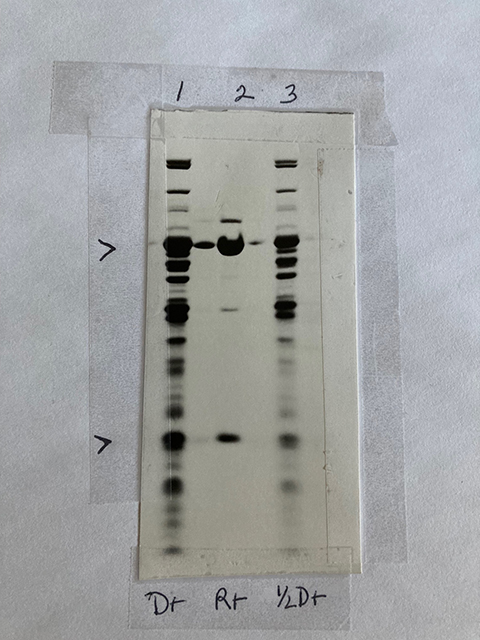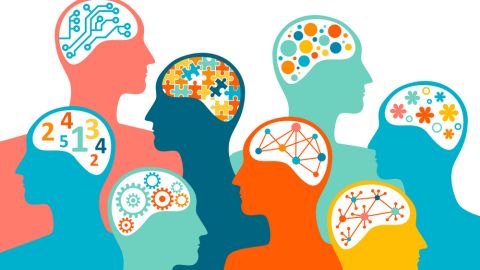
Water rescues the enzyme
“I lost the enzyme.” A graduate student announced this late one Friday afternoon. An explanation followed.
Proteolytic activity had been applied to a dye affinity resin — but no activity was evident either in the proteins that passed through the resin or after the buffer was changed to conditions expected to elute the enzyme.

After years of successfully using the technique to isolate this naturally occurring enzyme from tissue extracts when I was working at the University of Texas Southwestern Medical Center in Dallas, this was our first attempt at the University of Maine to isolate a bacterially expressed, recombinant form of calpain-2.
Water came to the rescue.
How we got there
In teaching, we stress buffers and buffering as primary concepts, and we use them to deal with any protein — especially enzymes — at the bench.
Buffer pH and buffer choices really do matter for isolating your favorite and very individualistic protein. Of course, high-quality distilled deionized water is also essential as the base of the buffers. Most enzymes tend to be finicky.
Some basic facts to appreciate:
- Reducing agents are important additions to buffers because the calcium-dependent proteolytic enzyme now known as calpain-2 has a cysteine in the active site and numerous other reduced cysteines.
- If enough calcium is bound by the enzyme, it self-destructs (autoproteolysis); thus, buffers containing chelators are used to protect it.
- Calpain-2 tends to precipitate near its isoelectric point, which for mammalian enzymes is typically pH about 5.5 so the preferred buffers for its isolation are pH 7-7.5, a range compatible with its optimal activity.

When I was at UT Southwestern, cow hearts were delivered on request (and were our preferred starting material). For isolating Mother Nature’s variant of calpain-2, we achieved excellent results with salt gradient elution from a weak anion exchanger in combination with dye affinity chromatography.
Using reactive red agarose required some trial and error to establish reproducible results in 1982 but was successful. Calpain-2 bound to the dye when applied in a buffer containing sodium chloride with chelators and reducing agents and was eluted with the same buffer lacking sodium chloride.
Before commercial sources of the enzyme existed, these methods allowed us to share calpain-2 with a number of laboratories and to generate antisera that were also widely shared. Enzymes do school you in what they need — if you listen to them.
John Elce’s group at Queen’s University in Ontario first reported in the Journal of Biological Chemistry the successful co-expression of both subunits of calpain-2, a rat sequence with a short carboxy-terminal extension including a hexa-his tag on the catalytic subunit and an amino-terminal truncation of its small subunit that removes the glycine-rich domain of about 90 residues. The resulting protein mimics a form of active, but autoproteolyzed calpain.
The Elce lab generously shared their constructs with us here in Maine and many others, and we set out to apply our usual isolation protocol to the bacterially expressed, recombinant calpain-2, with the added benefit of now having the hexa-his tag to allow a second affinity chromatography step using nickel-resin.

Back to our lost enzyme
The recombinant calpain-2 behaved as expected on ion exchange and seemed to bind to the dye affinity column, but for elution, the enzyme failed to cooperate.
The problem fell to me because the student had other commitments for Saturday. And yes, because experience counts sometimes.
Although enzymes can be lost, in a way, through denaturation or degradation, I suspected that recombinant calpain-2 was just hiding — playing hard to get. Given the small differences in the enzyme sequence from the naturally occurring enzyme, it was quite a surprise. At the time, in the mid-1990s, the general thinking was that deletion of the CAPNS1 amino-terminal region might even decrease hydrophobic interactions.
With the column brought from the cold room to the bench, I spent significant hours trying alternative solutions to coax the enzyme from the column: higher ionic strength, lower and lower buffer concentrations. Feeling frustrated and a bit desperate, I finally just used water — and, remarkably, that worked.
We minimized the exposure of the enzyme to water alone by having a buffered solution in the collecting tubes. Having control of the composition of the buffer that greeted the water-eluted enzyme was convenient for streamlining the purification process.
I later enjoyed a sabbatical leave in the Elce lab at Queen ’s University and demonstrated to my skeptical host that this process also works with Ontario water. Using this alternative method of purifying calpain-2 contributed to their efforts to crystallize the enzyme and to be the first group to solve its structure.
It always feels wrong to use only good-quality distilled-deionized water to elute a finicky enzyme from an affinity resin. However, sometimes you must bend the rules to get what you want, and we are very thankful that it works.
Read more
Read more articles and essays about our ASBMB Molecule of the year.
Water, you say? Sephra Rampersad recalls a great scientist asking, what is the one critical component that could make or break your experiment in any lab?
Water takes center stage Danielle Guarracino remembers the role water played at two moments in her life, one doing scary experiments and one facing a health scare.
What I’ve learned about water, aging and protein quality control Alice Liu thought an increase in heat shock protein chaperones would prevent misfolding in Huntington’s disease proteins. The results surprised her, and water was the key.
The subtle strength of hydrogen bonds Indu Sridharan remembers how water complicated her atomic force microscopy imaging studies of collagen.
The teaching power of water “I questioned whether children would be very interested in this exercise; there wasn’t much to it.” At an outreach event, Jessica Desamero learns that three cups of water can convey complex science.
There are worse things in the water than E. coli E. coli levels determined whether Olympic swimmers could dive into the Seine this past summer. But are these bacteria the best proxy for water contamination? Andrea Luis investigates.
Molecular impressions of water as cuneiform cascade Inspired by "the most elegant depiction of H2O’s colligative features," Thomas Gorrell created a seven-tiered visual cascade of Sumerian characters beginning with the ancient sign for water.
Virtual issue celebrates water in ASBMB journals Check out a dozen gold open-access articles covering exciting research about the society’s 2024 Molecule of the Year.
Enjoy reading ASBMB Today?
Become a member to receive the print edition four times a year and the digital edition monthly.
Learn moreGet the latest from ASBMB Today
Enter your email address, and we’ll send you a weekly email with recent articles, interviews and more.
Latest in Opinions
Opinions highlights or most popular articles

Sketching, scribbling and scicomm
Graduate student Ari Paiz describes how her love of science and art blend to make her an effective science communicator.

Embrace your neurodivergence and flourish in college
This guide offers practical advice on setting yourself up for success — learn how to leverage campus resources, work with professors and embrace your strengths.

Survival tools for a neurodivergent brain in academia
Working in academia is hard, and being neurodivergent makes it harder. Here are a few tools that may help, from a Ph.D. student with ADHD.

Hidden strengths of an autistic scientist
Navigating the world of scientific research as an autistic scientist comes with unique challenges —microaggressions, communication hurdles and the constant pressure to conform to social norms, postbaccalaureate student Taylor Stolberg writes.

Black excellence in biotech: Shaping the future of an industry
This Black History Month, we highlight the impact of DEI initiatives, trailblazing scientists and industry leaders working to create a more inclusive and scientific community. Discover how you can be part of the movement.

Attend ASBMB’s career and education fair
Attending the ASBMB career and education fair is a great way to explore new opportunities, make valuable connections and gain insights into potential career paths.

